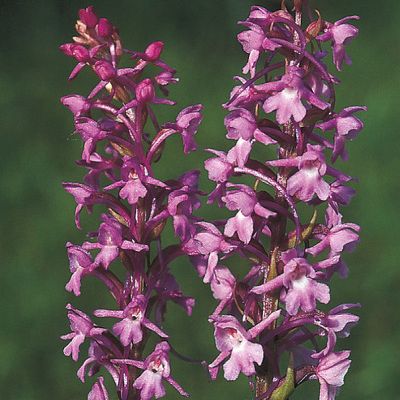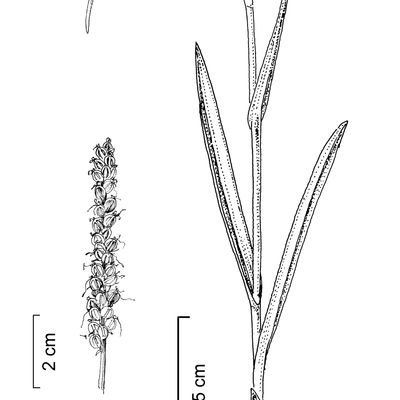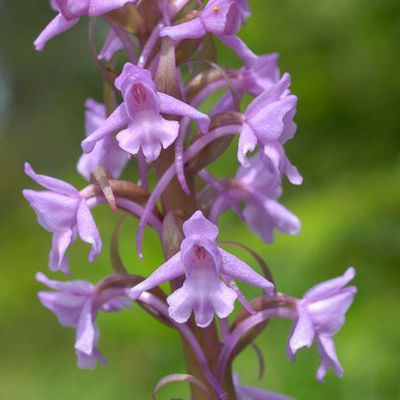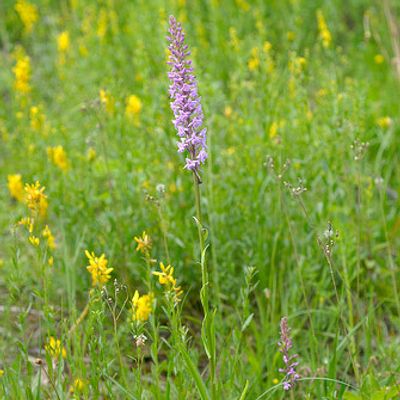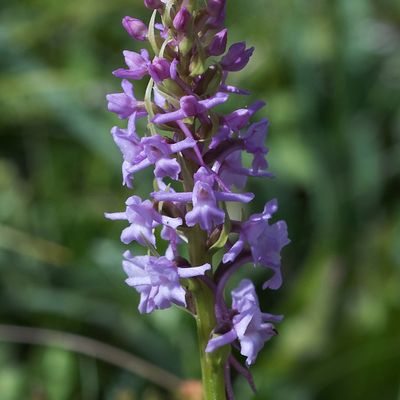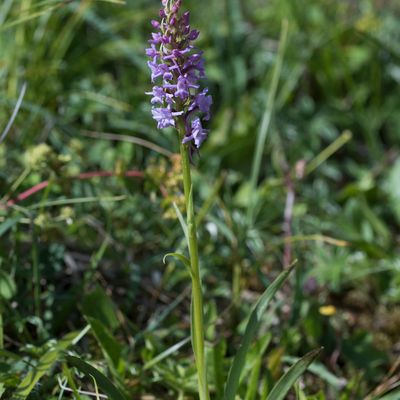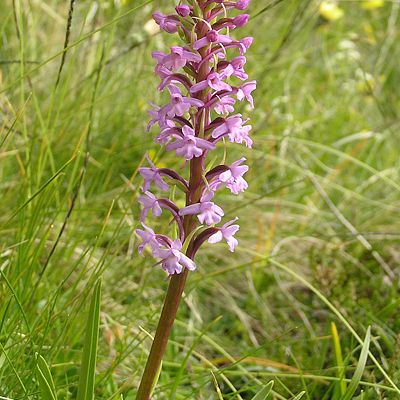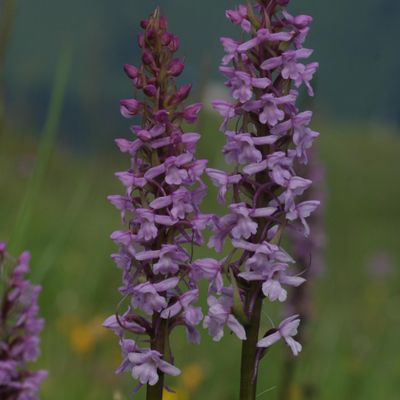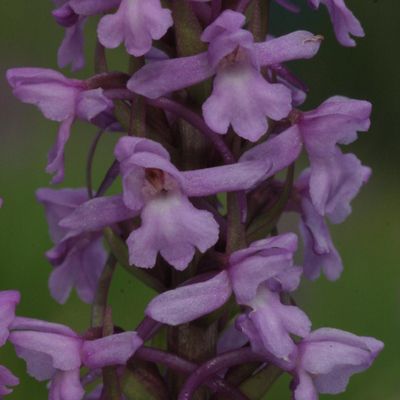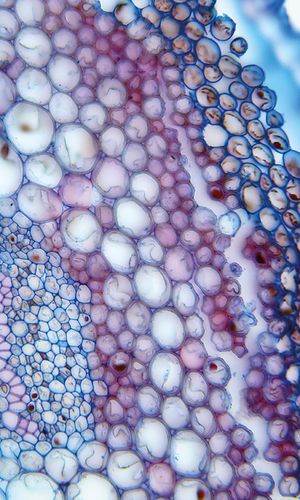Gymnadenia conopsea (L.) R. Br.
1021950
Species
ISFS : 193200
Checklist : 1021950
ISFS : 193200
Checklist : 1021950
Synthesis
Species description (© Flora Helvetica 2018)
Stängel 20-50 cm hoch, beblättert. Blätter lanzettlich, 5-20 mm breit, aufrecht, etwas rinnig. Blütenstand bis 15 cm lang, zylindrisch, dichtblütig. Blüten violettrot oder lila bis weisslich, wohlriechend. Seitliche äussere Perigonblätter abstehend, 5-6 mm lang, übrige zusammenneigend. Lippe etwa so lang wie die Perigonblätter, mit 3 +/- gleichen, gerundeten Abschnitten. Sporn dünn, sichelförmig abwärts gebogen, 1,5-2mal so lang wie der Fruchtknoten.Flowering period (© Flora Helvetica 2018)
5-6Habitat and distribution inside Switzerland (© Flora Helvetica 2018)
Feuchte Wiesen, lichte Wälder, trockene Weiden und Rasen / kollin-subalpin(-alpin) / CHWorld distribution (© Flora Helvetica 2018)
EurosibirischEcological indicator (© Landolt & al. 2010)
3w+42-43+3.g.2n=40(80)Status
IUCN status
Least concernNational Priority
K - no national priorityInternational responsibility
K - noneConservation
Threats
Anatomy
Summary of stem anatomy (German)
Umriss rund oder oval. Kleine Interzellularen, oft dreieckig. Epidermiszellen nicht verholzt.Description
Culm-diameter 2-5 mm, wall very large, radius of culm in relation to wall thickness approximately 1:0.75. Outline circular with a smooth surface. Center hollow and surrounded by many large thin-walled, not lignified cells. Without cortex/cylinder separation. Culm without endodermis but with a sheath of lignified cells around the center. Epidermis thin-, peripheral thicker-walled (lignified). Large vascular bundles arranged in one peripheral row. Chlorenchyma present, continuous peripheral belt with unlignified round cells (like a large cortex). Vascular bundles concentric, phloem in the center. Sheath around vascular bundles absent or not lignified. Vessels in vascular bundles around the phloem not to recognize in normal light. Largest vessel in the bundle small, < 20 μm. Cavities (intercellulars) between parenchyma-cells small, often triangular.Distribution map
Habitat and distribution inside Switzerland
CHWorld distribution
EurosibirischEcology
Life form
Geophyte
Habitats
Milieux Phytosuisse (© Prunier et al. 2017)
Habitats © Delarze & al. 2015
 | 4.2.4 - Mitteleuropäischer Halbtrockenrasen (Mesobromion) |
bold
Dominant species, influencing the appearance of the habitat
 Character species
Character species
 Less strictly linked to a specific habitat
Less strictly linked to a specific habitat
Ecological indicator values by © Landolt & al. (2010)
| Soil factors | Climatic factors | Salinity tolerance | |||
|---|---|---|---|---|---|
| Humidity Value H | 3w+ | Light Value L | 4 | Salinity Index | -- |
| Reaction Value R | 4 | Temperature factor T | 3+ | ||
| Nutriments value N | 2 | Continentality K | 3 | ||
- Ecological values legend
Humidity Value H 1 very dry 1+ dry 2 moderatly dry 2+ moist 3 medium wet 3+ wet 4 very wet 4+ soggy 5 submerged or underwater f plants living in running water u mostly submerged plants v partly submerged, partly floating plants w humidity moderately variable (± scale of 1-2) w+ highly variable humidity (scale exceeding ± 2) Reaction Value R 1 Very acid (pH 2.5-5.5) 2 acid (pH 3.5-6.5) 3 lightly acid to neutral (pH 4.5-7.5) 4 neutral to basic (pH 5.5-8.5) 5 basic (pH 6-5 -> 8.5 Nutriments value N 1 very low in nutrients 2 low in nutriments 3 medium-poor to medium-rich in nutrients 4 rich in nutriments 5 very rich in nutriments Salinity tolerance 1 halotolerant 3 halophyle Light Value L 1 very shady 2 shady 3 lighted areas 4 luminous 5 highly luminous Temperature factor T 1 alpine to nival stages (from the treeline to the snowline) 1+ suprasubalpine and upper subalpine levels (pine and larch forests) 2 subalpine level (coniferous forests without beeches up to the upper limit of spruces) 2+ lower subalpine and upper mountain stages 3 mountain level (beech and silver fir forests, in the central Alps Scots pine forests) 3+ lower mountain and upper hill levels 4 hill level (mixed deciduous oak forests) 4+ hot places, hill level 5 very hot places, hill level (only in the hottest places, typical of southern Europe) Continentality K 1 Atlantic (high air humidity, very low temperature variations, mild winters) 2 Sub-Atlantic (high air humidity, low temperature variations, relatively mild winters) 3 sub-Atlantic to subcontinental (average air humidity, moderately variable temperature, slightly low winter temperatures) 4 subcontinental (low air humidity, large temperature variations, rather cold winters) 5 continental (very low air humidity, very large temperature variations, cold winters)
Water dependency
| Rivers | |
| Calm water | |
| Ground water |
Nomenclature
Accepted Name (Checklist 2017)
Gymnadenia conopsea (L.) R. Br.
Vernacular name
Deutscher Name :
Langspornige Handwurz, Mücken-Handwurz, Mücken-NacktdrüseNom français :
Orchis moucheronNome italiano :
Manina roseaMatch with other reference books
| Relation | Nom | Book | No |
|---|---|---|---|
| = | Gymnadenia conopsea (L.) R. Br. | Checklist 2017 | 193200 |
| = | Gymnadenia conopsea (L.) R. Br. | Flora Helvetica 2001 | 2957 |
| = | Gymnadenia conopsea (L.) R. Br. | Flora Helvetica 2012 | 2541 |
| = | Gymnadenia conopsea (L.) R. Br. | Flora Helvetica 2018 | 2541 |
| = | Gymnadenia conopsea (L.) R. Br. | Index synonymique 1996 | 193200 |
| = | Gymnadenia conopsea (L.) R. Br. | Landolt 1977 | 756 |
| = | Gymnadenia conopsea (L.) R. Br. | Landolt 1991 | 663 |
| = | Gymnadenia conopsea (L.) R. Br. | SISF/ISFS 2 | 193200 |
| = | Gymnadenia conopsea (L.) R. Br. | Welten & Sutter 1982 | 2536 |
= The taxon corresponds to the accepted taxon (Checklist 2017)
< The taxon is included in the accepted taxon (Checklist 2017)
> The taxon includes (among others) also the accepted taxon (Checklist 2017)
< The taxon is included in the accepted taxon (Checklist 2017)
> The taxon includes (among others) also the accepted taxon (Checklist 2017)
Status
Native status
-IUCN list of endangered species (© Walter & Gillett 1997) : No
Status on national Red List 2016
IUCN status:
Least concern

Additional information
IUCN criteria: --
Status on regional Red List 2019
| Biogregraphic regions | Status | IUCN criteria |
|---|---|---|
| Jura (JU) | LC | |
| Mittelland (MP) | NT | A4c |
| Alpennordflanke (NA) | LC | |
| Alpensüdflanke (SA) | LC | |
| Östliche Zentralalpen (EA) | LC | |
| Westliche Zentralalpen (WA) | LC |
- Legend
EX Extinct RE Regionally Extinct CR(PE) Critically Endangered, Probably Extinct CR Critically Endangered EN Endangered VU Vulnerable NT Near Threatened LC Least Concern DD Data Deficient NE Not Evaluated NA Not Applicable
National Priority Species List Status
| No national priority or international responsability |
Protection status
| International (Bern Convention) | No | |
| AG | total protection | (01.01.2010) |
| AI | total protection | (13.03.1989) |
| BE | total protection | (01.01.2016) |
| FR | partial protection | (12.03.1973) |
| GL | total protection | (07.05.2006) |
| GR | total protection | (01.12.2012) |
| JU | total protection | (06.12.1978) |
| Switzerland | total protection | |
| OW | total protection | (01.04.2013) |
| SO | partial protection | (23.02.1972) |
| VD | total protection | (02.03.2005) |
| ZG | total protection | (01.10.2013) |
| ZH | total protection | (03.12.1964) |
| TI | total protection | (23.01.2013) |
- Disclaimer
InfoFlora compiles information on protected species as accurately as possible, taking it from the respective cantonal laws. In some cases, however, it was not possible to use the plant names as listed in the original text, but an interpretation of their taxonomy or nomenclature was necessary. The exact meaning of the categories „completely protected“ and „partially protected“ differs among the cantons.
InfoFlora cannot guarantee that the information on the protection status is correct and complete. In case of doubts, we recommend to look up the texts of the respective cantonal law.
Status by sector of activity
| Agriculture-related environmental objectives : | L - | more informations |
| Forest management environmental objectives : | more informations |
